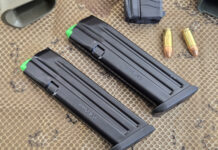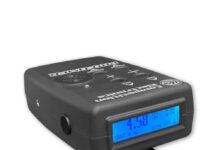For many of us who are about this life, getting to a point where we’d end up flying with firearms is probably inevitable. Whether we’re taking business trips, going to a specific class or even going to a serious level match–at some point, if you’re more than a casual gun hobbyist, you’ll probably end up having to fly with a firearm. This is a topic ripe with horror stories, fuddlore, bullshit and everything in between. My friend Tim Herron wrote about the topic, and what he wrote is worth your time.
–PE Fitch
From Tim Herron,
Flying With Firearms In The Domestic US
The Check-In Process
There always seems to be a lot of speculation, worry and apprehension regarding flying with firearms.
The check in process is actually quite easy. I’d like to share a process that ensures ease of travel with little hassle and fewer worries.
First, depending on the airport you’re departing from, you’ll want to arrive at least a full hour or more prior to your scheduled flight. Larger airports will always have longer lines and more passengers filtering through security, so add more time accordingly. When you arrive at the airport, you’ll go to the ticket counter to check your bags. At the counter, you’ll hand your ID to the agent and let them know you have __ number of bags to check. This is also the time to let them know you need to “declare a firearm.”
The agent will ask you to put the particular bag containing the firearm(s) on the scale to check them in. They will then hand you a firearms declaration card for you to complete with all of your pertinent information (name/address/date/travel info/etc). You’ll have to sign this card and declare that the firearm(s) are unloaded, clear of any ammunition and in safe condition.
The agent will ask you to open your bag in order to visually and/or physically inspect your firearm case to ensure it is locked and inaccessible. Sometimes, gate agents might request that you open the container with the firearm itself. This is okay, don’t freak out and DO NOT handle the firearm. Once they inspect it, they’ll have you secure your case and they will insert the completed declaration card inside the suitcase or the firearms container before locking it up again.
The agent will give TSA a quick call or send them the bag directly for inspection. Follow any and all directions for any other bags you need to check and any and all other specific airport or gate procedures. Once the bag and firearm has been inspected by TSA, you may receive an “all clear” or perhaps be directed to your gate after check-in.
Flying With Ammunition
I personally recommend packing ammo in a suitcase separate from the firearm. Keep in mind that most airlines have an 11-lb weight limit for ammunition, but some do not. Your best bet is to call them ahead of time and see their policies. Rounds are usually best off left in their factory packaging. Sometimes, I travel with cartridges stored in plastic MTM or Berry’s boxes and I’ll add some blue tape around the edges to protect them. While certain airlines might allow you to fly with loaded magazines, most generally don’t and it’s a crap shoot to guess incorrectly and find out the hard way. Honestly, I don’t recommend doing this to avoid wasting your time. Interestingly, there is no federal/TSA weight limit for ammunition. Technically, you also don’t need to declare it. It’s why I recommend traveling with ammo separate from the firearm in a different bag. Keep in mind that ammo does need to be in “checked baggage” but not declared or inspected by the airline. This allows you to circumvent the 11-lb limit and fly with extra rounds.
My Choice Of Cases And Containers
Above is a photo of the hard case I recommend as well as the firearms case I used to secure my handguns. The large case is a Pelican 1615 Air and has 5 latches (2 are TSA approved locks). Inside, I pack my range bag (with all things needed for range work), my belt/holster, trauma kit, marker cones (for range), and a firearms case containing pistols and empty magazines. My firearms specific case is a Pelican V200. I secure the V200 with two NON-TSA approved padlocks with the shortest shackle length I can get away with. This way, no one else has access to that locked case. I fly with a second Pelican 1615 Air that contains all my other travel and teaching essentials like ammo, rain gear, boots/shoes, extra jacket, gloves, notebook, etc. This case does get locked with TSA Approved locking latches for ease of inspection and security. Both of these cases have everything I need for a weekend class or match. Both end up weighing around 46-48 pounds. This is enough to avoid any overweight bag fees. For my own assurance, peace of mind and tracking of my luggage, I use Apple iTags in each case as well too. I highly recommend them.
PS…
I prefer hard cases like the 1615 Air due to the immense amount of travel and handling they’re subjected to. These cases are extremely durable and they keep all of my stuff safe. I’ve used soft suitcases and less rugged luggage in the past, but they don’t last the way these hard sided Pelican cases do. The biggest piece of advice and most important recommendation I can give you is…BE NICE! Being an impatient and inconsiderate passenger will make you trouble. You’d be amazed at how just having a pleasant attitude and accommodating demeanor will smoothen your travels. (Trust me, I know ;-) )
–Tim Herron
Tim Herron is a nationally acclaimed firearms instructor and competitive shooter. He is a USPSA Grand Master in both Single Stack and Limited division, a Master Class CDP shooter in IDPA, and has experience in defensive shooting, IDPA, Steel Challenge, bullseye and target shooting, Bianchi, and the occasional trick shot. Please visit his website to learn more about what he does and what he teaches.




